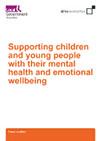
Introduction
Background and importance of this study
These case studies cover a range of good practice in mental health and emotional wellbeing support for children and young people, with a particular focus in some places on the transition from children’s and adolescents’ mental health services (CAMHs) to adult mental health services (AMHs) or out of CAMHs when the young person reaches the end of their programme of support.
Mental health and emotional wellbeing has never been as important as it is now. Recent studies suggest that one in six young people have a mental health problem in 2020, rising from one in nine in 2017 and three quarters of mental health problems emerge before the age of 24. Children and young people with mental health problems are more likely to be excluded, and they are also more likely to come from poorer households.
Transitions from childhood to adulthood is a difficult time for everyone, but it is also a crucial period that can define personal development and life opportunities as an adult. The challenges related to this transition are even more pronounced for young people with mental health difficulties, who are likely to need additional support.
Providing community services with an early help approach is important, which is also reflected in young people’s preferences. Available studies show that young people would like mental health services to be: (a) non-stigmatising, (b) open access, and (c) based in community settings.
The case studies provided
The following case studies stand as examples of good practice, success stories and promising initiatives in supporting young people with their mental health. From these case studies, it is clear that work around transitions cannot happen in isolation, and, early intervention and prevention are of critical importance as well. Providing young people with the mental health support they need in a timely fashion reduces the potential of having their symptoms escalating and results in smoother transitions taking place (or, to no transition being needed at all). Some of the case studies featured look at effective transition between services that is based on the service users’ individual needs and preferences. Thus, this study takes a broad approach to mental health support to present a series of best practices that all have the interest of young people at the centre of their approaches.
A total of 10 interviews, approximately 60 minutes long each, were conducted, with one or two people from the Councils, the Clinical Commissioning Group (CCG) and the voluntary sector attending each time and speaking about their partnership approach.
We have thus collected a range of notable practices and approaches. We have chosen seven case studies across Councils in England that can be a resource for other Councils to read and extract ideas as to how they can better support young people.
To design and deliver a service that is truly attending to young people’s needs, it is essential to listen and incorporate the voices of young people themselves, regarding their needs and their views on the services offered to them. Thus, we also provide a separate, anonymous section including: i) the voices of young people who have experienced transitions between mental health services with whom we talked for this study, and ii) the views expressed by young people supported by 42nd Street in the co-creation of a young adults service in Greater Manchester as part of the Transforming Community Mental Health programme (March 2021).
The impact of the ongoing COVID-19 pandemic was also discussed in all interviews conducted for the present study, and is presented alongside other overarching themes in this report.
The LGA commissioned Alma Economics to undertake the research for the case studies and used this research to draw out the key messages.
Key messages
• The voice of children and young people, and their parents and carers, needs to be at the centre of service development and individual practitioners need to be aware of the impact that they can have on young people’s trust in a service.
• Promising approaches include self-referrals or open access services which provide a welcoming place for young people, where they can access a range of different services and do not feel stigmatised to access support.
• Young people told us that when they have a well-coordinated transition between services, and their support worker understands them, then this can make a significant difference to how settled they feel in the new service.
• Digital support, such as online counselling, can be a valuable additional tool for councils to use to support young people. It can extend the reach of services and may have shorter waiting times than face to face services. However, services need to be aware of young people’s individual circumstances or access to technology before it is seen as a replacement.
• A focus on early intervention will reduce pressure on services over time and enable children and young people to access services when they need it most. However, some young people can feel that their needs aren’t ‘serious’ enough, and may delay accessing services until they reach crisis point.
Overarching themes
In spite of the diversity of the case studies and the approaches adopted by each partnership that we have presented in this report, we have identified a number of recurring themes in most, if not all, of the interviews that we conducted. Below we present the most important ones, which we believe that would be beneficial for Councils to consider when improving their mental health support for young people.
Listening to young people's voices
Below we provide a discussion of young people’s experiences and needs in relation to mental health support and transitions. The points raised were identified during our interviews with young people and from reading the views expressed by young people supported by 42nd Street in the co-creation of a young adults service in Greater Manchester as part of the Transforming Community Mental Health programme (March 2021).
The following quotes are taken from our interviews with young people and are used instead of topic-specific headings, as we believe that young people’s own words capture the best way possible the context for discussion.
I didn’t have a great first counsellor experience and this made me reluctant to ask for more help along the way.
Given that young people usually reach out to mental health services for the first-time during adolescence (around the age of 15), their first experience of therapy is formative. A bad or not so useful experience, we have been told, can result in reluctance to ask for further help later in the future. The lack of time for engagement by mental health counsellors, the confusion over the purpose of each therapy and its anticipated outcomes as well as the discontinuity of communication and contact from the services, can all lead to the young person to stop engaging with mental health services.
All you just want is to be shown some compassion… and not to feel like a statistic.
Young people reported that they would have liked the opportunity for greater engagement with the mental health professional supporting them, but also on behalf of the system.
Not establishing a relationship with the therapist was perceived as a lack of understanding and empathy. Young people felt that being listened to for the sake of meeting the requirements of an appointment did not make a positive difference for them; instead they asked for active dialogue with the therapists and counsellors to take place during their sessions.
Having their names called or spelled wrong – or even being taken for somebody else – while changing services was also reported as an additional layer of distress and of making young people who were already at a vulnerable stage to feel that there was no actual interest for them.
To be honest with you, it wasn’t a transition.
The pandemic has manifested gaps in the system that had been perpetuating for too long. Young people who turned 18 during the pandemic and had to change services while being in lockdown, told us that there was no actual ‘handover’ from one service to another and that they had to navigate the system alone. Mental health support in schools, colleges and Universities has been filling this gap where possible, even before the onset of COVID-19. Young people we spoke with mentioned that mental health professionals from the education environment became their unofficial points of contact, supporting them while juggling with threshold criteria for numerous services and helping them familiarise themselves with the options available to them.
A source of additional distress are the dual diagnoses sometimes resulting from two separate services, as well as a change in medication without prior consultation with the patient, in which young people feel that they have no influence.
When you turn 18, you disappear, you are no longer part of the service.
Young people mentioned that the closer they would get to turning 18 the more they would experience anxiety and uncertainty over the continuity of the care they were receiving. Coming of age is supposed to be a memorable experience in an individual’s lifetime, one that they look back in reminiscence. On the contrary, young people who had to transition when becoming legally adults, have experiences of dismissal to recall – in certain cases of being turned away their CAMHS therapists in spite of struggling because the service could not assist them anymore as adults.
The age of 18 also initiates other life changes that young people can find challenging and, without the appropriate support, can make their conditions escalate. Moving away to go to University is one such example; young people saying that when moving to a different city in England, they had to start their approach to mental health services from scratch, even though they were registered with CAMHS before that. Establishing communication channels among mental health services at a national level could remarkably narrow this gap, according to young people’s opinions.
I almost regret there was no intervention sooner for me.
Though the numbers vary locally, there is unanimous agreement that waiting lists are long beyond the point of what is sustainable in terms of service provision and also – and most crucially – to meet young people’s needs before their symptoms escalate.
While in this report we have identified initiatives that promote early intervention and prevention precisely for young people not to reach a breaking point before they can access services, feedback we received from young people themselves illustrates an additional factor. In certain cases, a reluctance is observed to referring people to services unless they present acute difficulty. Examples shared with us included young people being on the verge of panic attacks, self-harm or overtaken by suicidal thoughts when they were eventually referred to the appropriate services.
Not all young people had negative experiences to share and not all services are affected by what is mentioned above. The local context plays a great role in the provision offered and depending on where young people had accessed services, they had different levels of (un)satisfaction to report.
Feedback on what has worked particularly well for young people, includes:
- Being a member of a therapeutic group, especially in terms of having the opportunity to interact with other service users and to be surrounded by other young people who share similar experiences. One young person also reflected that for the period they had attended regular therapeutic group meetings, they presented less of a need for one-to-one professional support.
- Having long-term, committed treatments instead of short and sparse appointments with services plays a decisive role in young people’s engagement with the therapeutic process. Young people’s feedback also indicates that this approach provides better and more sustainable outcomes.
- Cognitive Behavioural Therapy (CBT) has been reported as more suitable for children and young adolescents as opposed to counselling. The latter requires a greater level of reflection that may be hard to achieve at such a young age.
Furthermore, and of critical importance, young people acknowledged that the issues identified were not due to lack of interest on behalf of their therapists and counsellors, but due to overburdened services and limited resources. To bring this section to a close with their own words, young people told us:
If money wasn’t a thing, [we need] more services!
You can’t hold people to account, because they do see a lot of people…







